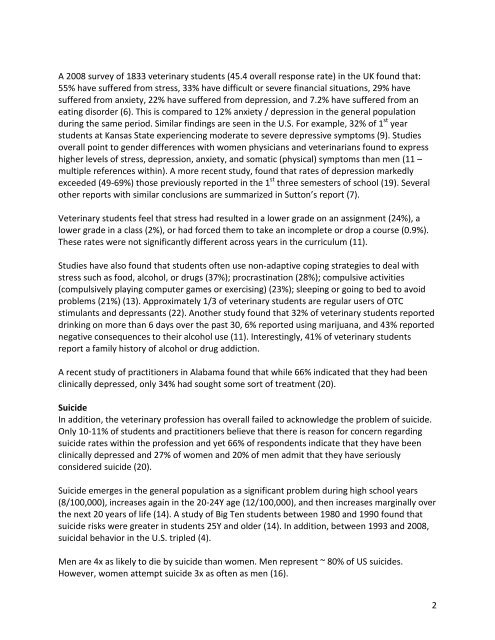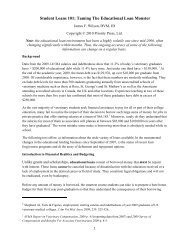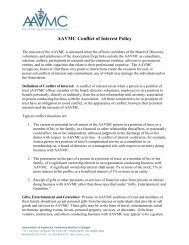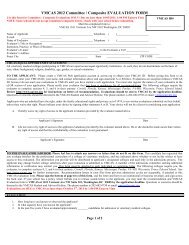Draft Dec 30, 2012 Health and Wellness for Our Students – The ...
Draft Dec 30, 2012 Health and Wellness for Our Students – The ...
Draft Dec 30, 2012 Health and Wellness for Our Students – The ...
Create successful ePaper yourself
Turn your PDF publications into a flip-book with our unique Google optimized e-Paper software.
A 2008 survey of 1833 veterinary students (45.4 overall response rate) in the UK found that:55% have suffered from stress, 33% have difficult or severe financial situations, 29% havesuffered from anxiety, 22% have suffered from depression, <strong>and</strong> 7.2% have suffered from aneating disorder (6). This is compared to 12% anxiety / depression in the general populationduring the same period. Similar findings are seen in the U.S. For example, 32% of 1 st yearstudents at Kansas State experiencing moderate to severe depressive symptoms (9). Studiesoverall point to gender differences with women physicians <strong>and</strong> veterinarians found to expresshigher levels of stress, depression, anxiety, <strong>and</strong> somatic (physical) symptoms than men (11 –multiple references within). A more recent study, found that rates of depression markedlyexceeded (49-69%) those previously reported in the 1 st three semesters of school (19). Severalother reports with similar conclusions are summarized in Sutton’s report (7).Veterinary students feel that stress had resulted in a lower grade on an assignment (24%), alower grade in a class (2%), or had <strong>for</strong>ced them to take an incomplete or drop a course (0.9%).<strong>The</strong>se rates were not significantly different across years in the curriculum (11).Studies have also found that students often use non-adaptive coping strategies to deal withstress such as food, alcohol, or drugs (37%); procrastination (28%); compulsive activities(compulsively playing computer games or exercising) (23%); sleeping or going to bed to avoidproblems (21%) (13). Approximately 1/3 of veterinary students are regular users of OTCstimulants <strong>and</strong> depressants (22). Another study found that 32% of veterinary students reporteddrinking on more than 6 days over the past <strong>30</strong>, 6% reported using marijuana, <strong>and</strong> 43% reportednegative consequences to their alcohol use (11). Interestingly, 41% of veterinary studentsreport a family history of alcohol or drug addiction.A recent study of practitioners in Alabama found that while 66% indicated that they had beenclinically depressed, only 34% had sought some sort of treatment (20).SuicideIn addition, the veterinary profession has overall failed to acknowledge the problem of suicide.Only 10-11% of students <strong>and</strong> practitioners believe that there is reason <strong>for</strong> concern regardingsuicide rates within the profession <strong>and</strong> yet 66% of respondents indicate that they have beenclinically depressed <strong>and</strong> 27% of women <strong>and</strong> 20% of men admit that they have seriouslyconsidered suicide (20).Suicide emerges in the general population as a significant problem during high school years(8/100,000), increases again in the 20-24Y age (12/100,000), <strong>and</strong> then increases marginally overthe next 20 years of life (14). A study of Big Ten students between 1980 <strong>and</strong> 1990 found thatsuicide risks were greater in students 25Y <strong>and</strong> older (14). In addition, between 1993 <strong>and</strong> 2008,suicidal behavior in the U.S. tripled (4).Men are 4x as likely to die by suicide than women. Men represent ~ 80% of US suicides.However, women attempt suicide 3x as often as men (16).2










